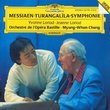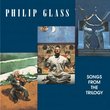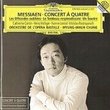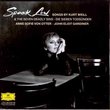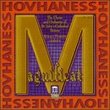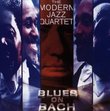| All Artists: Charles Ives, Michael Tilson Thomas, Chicago Symphony Orchestra Title: Ives: Holidays Symphony Members Wishing: 0 Total Copies: 0 Label: Sony Release Date: 10/25/1990 Genre: Classical Styles: Historical Periods, Modern, 20th, & 21st Century, Symphonies Number of Discs: 1 SwapaCD Credits: 1 UPC: 074644238129 |
Search - Charles Ives, Michael Tilson Thomas, Chicago Symphony Orchestra :: Ives: Holidays Symphony
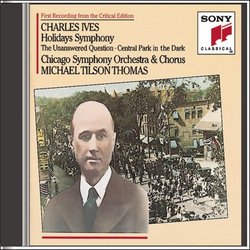 | Charles Ives, Michael Tilson Thomas, Chicago Symphony Orchestra Ives: Holidays Symphony Genre: Classical
Ives never really intended his four holiday symphonic poems to be played together, and they are very seldom performed that way live. But it makes so much sense to group them on a recording that the Holidays Symphony has ... more » |
Larger Image |
CD DetailsSynopsis
Amazon.com essential recording Ives never really intended his four holiday symphonic poems to be played together, and they are very seldom performed that way live. But it makes so much sense to group them on a recording that the Holidays Symphony has become the standard way to refer to the music. In any event, all four pieces offer some of Ives'ss finest, most imaginative work. The Fourth of July is the second most complex and crazy piece that he ever wrote--right up there with the second movement of the Fourth Symphony. Tilson Thomas is very much a specialist in this music, and he directs performances of almost supernatural accuracy. Simply the best. --David Hurwitz Similarly Requested CDs
|
CD ReviewsMy vote for the finest Ives orchestral recording ever made Gail Hightower | Boston | 09/23/2002 (5 out of 5 stars) "Take the insight of Michael Tilson Thomas, who's been conducting Ives throughout his career (his old Boston Symphony "Three Places" is still one of the best around), add one of the finest orchestras in the world and its celebrated brass section (Ives said he conceived all his music as if through "sort of a brass band with wings"), and finish with some genuinely inspired playing, and you've got a recording for the ages. It was a broadcast of the Chicago live performance, heard by chance on the radio, that gave me the idea to write my biography of Ives. Meanwhile the Holidays Symphony is one of Ives's greatest and most communicative works, and the "Decoration Day" movement one of the summits of his music. When Stravinsky was asked to define a masterpiece, he answered with "Decoration Day."" "Thanksgiving and Forefathers' Day": It's what's for today. Bob Zeidler | Charlton, MA United States | 11/27/2003 (5 out of 5 stars) "The "Holidays Symphony" of Charles Ives, comprised of four movements to symbolize the passing of the four seasons by connecting them to important American holidays, was originally intended to be four standalone works, each of which could be performed separately in conjunction with its respective holiday. Only later did Ives combine them as a four-movement "symphony." So, on this Thanksgiving Day of 2003, I chose to "deconstruct" them, just so that I might concentrate - for the occasion - on "Thanksgiving and Forefathers' Day." This movement should, in my opinion, be numbered among the finest Ives compositions of all. It is brilliantly written and scored, with many original instrumental touches, particularly for percussion, where Ives calls upon low church bells, tubular bells and celesta, as well as an offstage ensemble of 4 horns, trombone and contrabassoon, all to marvelous effect. The ending, where the chorus enters singing to the words of the hymn tune "Duke Street," is simply breathtaking in its spirituality; truly transcendent and sublime. But there are aspects to this movement that I've not seen anyone else mention, aspects that are startling in a prescient way, and therefore worth some mention. There is a quiet interlude, at about midpoint, scored for a reduced chamber ensemble of woodwinds, cornet, strings and celesta, that is "proto-Copland" in its sound texture, typical Coplandesque "Americana" yet written decades before "Appalachian Spring," which this section anticipates in a most remarkable way, with nearly identical chamber orchestra textures and, even, thematic ideas. The interlude then is followed by a penultimate section, prior to the choral entry, that has textures - and harmonies for that matter - similar to what William Schuman would, like Copland, write decades later. This brief section provides a perfect transition to the choral entry. And this is precisely where words fail me, because what Ives achieves here simply turns me to jelly. Only at the end of "From Hanover Square North" (from his Orchestral Set No. 2) and in the final movement of his masterpiece, the Symphony No. 4, was Ives able to match this "Holiday" in transcendent beauty. The other three holidays/seasons ("Washington's Birthday"/Winter, "Decoration Day"/Spring and "The Fourth of July"/Summer) are all of a piece with this Thanksgiving one. Tilson Thomas has this music in his blood, having been an Ivesian from a very young age as conductors go. The Chicago Symphony Orchestra, famed for its brass choir, earns kudos for ALL of its choirs in this performance, easily the best available and one not likely to be topped any time soon. And of course it doesn't hurt to have the Margaret Hillis-directed CSO Chorus for the conclusion of "Thanksgiving and Forefathers' Day" (the one movement that I just HAD to listen to, not that I excluded the rest of the work, or the disc for that matter). The album is nicely rounded out with Ives's two contemplations: "A Contemplation of a Serious Matter" and "A Contemplation of Nothing Serious," more commonly known as "The Unanswered Question" and "Central Park in the Dark." Better yet, "The Unanswered Question" appears in two versions: the original as written in 1906, and a revised version, written some 20-odd years later, in which the trumpet and woodwind phrases are somewhat altered to add to the enigmatic nature of the work. In both versions, the Chicago strings play with an atmospheric perfection rarely heard. The ragtime piano in the foreground of "Central Park in the Dark" is hard to top, also. But for this particular "contemplation" I do have a preference for James Sinclair's (British) Northern Sinfonia Orchestra performance (on Naxos #8559087), for which I had written, "Much of Ives's music is all about space and distance, and the bar-room piano heard very faintly in the background truly gives this sense of space, as well as a sense of evening mist in the park." The renowned Ives biographer Jan Swafford writes on this page, "My vote for the finest Ives orchestral recording ever made." I'm not of a mind to argue with Swafford, Ives expert that he is, especially on this particular day, and equally especially by virtue of the phenomenal performances that Tilson Thomas elicits from his Chicago orchestral and choral forces throughout. Cue it up, folks. It's "what's for Thanksgiving." Bob Zeidler" Fine Strong Symphonies Bob Zeidler | 05/02/1999 (5 out of 5 stars) "Tilson Thomas delivers the goods here. My first experience with the Holidays Symphony was Bernstein's recording, very dear in my memory. Tilson Thomas' is just as evocative, and digital to boot. My favorite is Thanksgiving and/or Forefather's Day - a very emotional, cathartic movement, very rewarding. The Unaswered Question is musically a simpler construction. A good recording for a High School music appreciation class, yet it isn't just program music. Play it for your young Junior High student and solicit a response... they might suprise you. Well performed."
|

 Track Listings (7) - Disc #1
Track Listings (7) - Disc #1
